Astronomy Before the Telescope
It is difficult to appreciate how important the sky overhead was to our ancestors. In an age of artificial light, the night sky has vanished for most city dwellers. Amateur astronomers travel hundreds of miles to find a location dark enough to reveal the wonders of the heavens. For our ancestors, the sky represented the chief means of telling time, of navigation, of knowing when to start planting crops. The sky was a practical tool of survival and they developed sophisticated tools for measuring the subtle changes from season to season, from month to month, and even from day to day. Surviving tools include the items shown below. Many ancient astronomical devices show up in auctions, including astrolabes, sundials, and astrological tables. Many of these are clever fakes, and many are simply crude reproductions, not intended to fool anyone, produced for the home decór market. Granted that a Mayan sacrificial temple is unlikely to appear on eBay anytime soon, but reproductions of astrolabes and other pre-telescopic devices do show up there. This page presents an assortment of genuine artifacts from museums around the world.
Click on a photo for a more detailed enlargement.
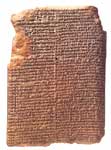 500 B.C. A late Babylonian tablet containing an important astronomical compendium. This tablet is only 8.4cm high, and
is a miniature masterpiece of Babylonian cuneiform writing. British Museum, WA 86378. The Babylonians developed precise
mathematical formulas for predicting astronomical events. Their mathematical theory is elegant, concise, and capable
of predicting lunar and planetary phases and positions with astounding accuracy. Many researchers feel the Babylonian
techniques represent the first true scientific revolution
500 B.C. A late Babylonian tablet containing an important astronomical compendium. This tablet is only 8.4cm high, and
is a miniature masterpiece of Babylonian cuneiform writing. British Museum, WA 86378. The Babylonians developed precise
mathematical formulas for predicting astronomical events. Their mathematical theory is elegant, concise, and capable
of predicting lunar and planetary phases and positions with astounding accuracy. Many researchers feel the Babylonian
techniques represent the first true scientific revolution
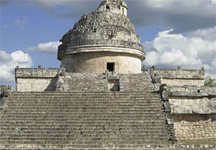
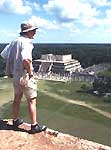 Venus, normally the third-brightest "star" in the sky, was of supreme importance to most old cultures. The Mayans conducted
raids against neighboring tribes by checking the position of Venus for the timing of a battle. The "Caracol" at Chichén
Itzá provided an elevated platform for making such observations. The northeast and southwest corners are aligned
perfectly with the winter solstice sunset and the summer solstice sunrise. The windows and several other features of the Caracol
are aligned with the position of Venus on the horizon when
it rises and sets at certain times of the year. The dense jungle makes it impossible to do any astronomy without a clearing,
and even then, the horizon is obscured by thick, high vegetation on all sides. I remember climbing the steps of Caracol. Suddenly, the incredibly flat panoply of the
jungle was spread out before me in all directions, like a vast green desert. The horizon was unobstructed all around. Had I
brought a telescope, this would have been the perfect place to set it up. I spent most of the evening at Chichén Itzá,
seeing the stars as our ancestors saw them (this was before it was developed into a tourist attraction and the site was flooded with artificial lighting, laser light shows, hotels, parking lots, etc.)
In the old days, on a moonless night I can remember it being
so dark that I could see my shadow by the light of Venus. Now I look for dark skies in ancient archaelogical sites that haven't been "developed".
Venus, normally the third-brightest "star" in the sky, was of supreme importance to most old cultures. The Mayans conducted
raids against neighboring tribes by checking the position of Venus for the timing of a battle. The "Caracol" at Chichén
Itzá provided an elevated platform for making such observations. The northeast and southwest corners are aligned
perfectly with the winter solstice sunset and the summer solstice sunrise. The windows and several other features of the Caracol
are aligned with the position of Venus on the horizon when
it rises and sets at certain times of the year. The dense jungle makes it impossible to do any astronomy without a clearing,
and even then, the horizon is obscured by thick, high vegetation on all sides. I remember climbing the steps of Caracol. Suddenly, the incredibly flat panoply of the
jungle was spread out before me in all directions, like a vast green desert. The horizon was unobstructed all around. Had I
brought a telescope, this would have been the perfect place to set it up. I spent most of the evening at Chichén Itzá,
seeing the stars as our ancestors saw them (this was before it was developed into a tourist attraction and the site was flooded with artificial lighting, laser light shows, hotels, parking lots, etc.)
In the old days, on a moonless night I can remember it being
so dark that I could see my shadow by the light of Venus. Now I look for dark skies in ancient archaelogical sites that haven't been "developed".
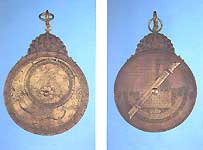 A.H. 1203 (A.D.1788/9). The astrolabe was originally invented by the Greeks, but made far more precise by Arab astronomers. The viewer looked through
a pair of sighting holes on each end of the long arm. The face of the astrolabe held a disc that could be removed and replaced
by other discs, much like a computer. Each disc was used in traveling for a different latitude. By sighting on certain stars and aligning the
astrolabe with the north star, the user could determine a precise time for his location. On the back is a sine/cosine quadrant
graphs of meridian latitutes for the sun for seven latitudes, graphs of azimuths of numerous stars, a shadow-square, scales of co-tangents, and
astrological tables. This astrolabe was made by Hajji Ali, and
is a fine example of the astrolabes made in Persia during the Safavid period. The maker is unique among astrolabe makers in numbering
his work. Ten of the fourteen astrolabes made by him were numbered.
A.H. 1203 (A.D.1788/9). The astrolabe was originally invented by the Greeks, but made far more precise by Arab astronomers. The viewer looked through
a pair of sighting holes on each end of the long arm. The face of the astrolabe held a disc that could be removed and replaced
by other discs, much like a computer. Each disc was used in traveling for a different latitude. By sighting on certain stars and aligning the
astrolabe with the north star, the user could determine a precise time for his location. On the back is a sine/cosine quadrant
graphs of meridian latitutes for the sun for seven latitudes, graphs of azimuths of numerous stars, a shadow-square, scales of co-tangents, and
astrological tables. This astrolabe was made by Hajji Ali, and
is a fine example of the astrolabes made in Persia during the Safavid period. The maker is unique among astrolabe makers in numbering
his work. Ten of the fourteen astrolabes made by him were numbered.
 The astronomical compendium at right was made by Johann Anton Linden in 1596. It consists of an astrolabe with a rete for 34 stars, a table with the
exact location of 29 stars, a lunar aspectarium, a table with the longitude and latitude of 70 towns, and a calendar fo the years
1596-1625. (British Museum MLA 57,11-67,1)
The astronomical compendium at right was made by Johann Anton Linden in 1596. It consists of an astrolabe with a rete for 34 stars, a table with the
exact location of 29 stars, a lunar aspectarium, a table with the longitude and latitude of 70 towns, and a calendar fo the years
1596-1625. (British Museum MLA 57,11-67,1)
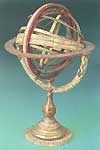 Late 17th-century Italian Copernican armillary sphere. Made of beechwood and covered with paper, with engraved, hand-drawn and hand-colored circles.
Marbled Florentine paper with gilt decoration. The sun is at the center, surrounded by an ecliptic (zodiac) circle and a polar circle. The underside is inscribed in ink die 29 Mensia Xtoris 1621. This date is
misleading. Paper was extremely expensive and and it was a typical Florentine practise to re-use it. The date refers to the paper, not the
armillary sphere.
Late 17th-century Italian Copernican armillary sphere. Made of beechwood and covered with paper, with engraved, hand-drawn and hand-colored circles.
Marbled Florentine paper with gilt decoration. The sun is at the center, surrounded by an ecliptic (zodiac) circle and a polar circle. The underside is inscribed in ink die 29 Mensia Xtoris 1621. This date is
misleading. Paper was extremely expensive and and it was a typical Florentine practise to re-use it. The date refers to the paper, not the
armillary sphere.
The written records of the Babylonians, the alignment of Stonehenge and the great sacrificial temples of the Mayans and Aztecs represent more than just tools for telling time and tracking the seasons. Behind the technological achievements is a complex symbolical structure--the mythology, the cosmology, the world view of ancient peoples. For more information on this fascinating aspect of ancient astronomy, see the Bibliography.